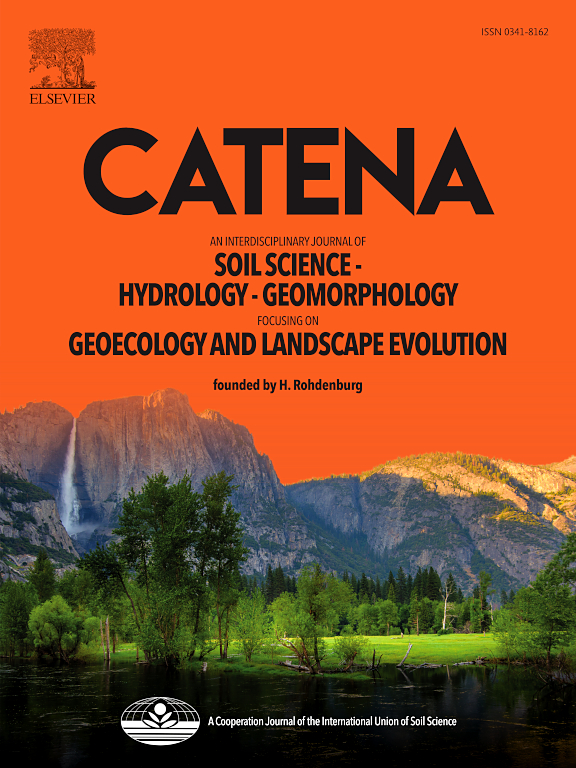Carbon and water fluxes are more responsive to water restriction in grassland than in forest ecosystem in the semiarid Loess Plateau, China
IF 5.7
1区 农林科学
Q1 GEOSCIENCES, MULTIDISCIPLINARY
引用次数: 0
Abstract
This study examined the responses of net ecosystem productivity (NEP) and evapotranspiration (ET) to environmental factors in forest and grassland ecosystems based on eddy covariance observations from 2020 to 2023. Wavelet analysis was employed to capture the cyclical fluctuations of carbon and water fluxes and assess the impact of water limitation across daily to annual timescales. Non-water restriction and water restriction periods were detected using Budyko’s aridity index. The results showed photosynthetically active radiation (PAR) was the most synchronous factor affected forest and grassland NEP, with NEP earlier than PAR 1.48 ± 11.27 h and 1.31 ± 9.35 h on daily timescale, respectively. Meanwhile, net radiation (Rn) was the most synchronous factor for forest and grassland ET, with ET earlier than Rn 2.40 ± 8.04 h and 2.28 ± 4.15 h on daily timescale, respectively. On annual timescales, air temperature (Ta) and PAR emerged as the primary synchronous drivers for forest and grassland NEP, respectively. While Rn influenced annual ET in both ecosystems, forest ET exhibited significantly longer lagtimes (−29.32 ± 18.47 d) compared to grassland (−27.55 ± 1.91 d). On daily timescale, the lagtime of NEP and ET in forest and grassland ecosystems with Ta was significantly were shorten on water restriction period compared with the non-water restriction period. On annual timescale, the lagtime of NEP and ET with solar energy and soil water were shorten during water restriction periods in forest and grassland ecosystems. Our finding highlighted NEP and ET in grassland exhibit a greater responsiveness to water restriction conditions than forest across various timescales.
黄土高原半干旱生态系统中,草地碳通量和水通量对水分限制的响应强于森林生态系统
基于2020 - 2023年的涡旋相关方差观测,研究了森林和草地生态系统净生态系统生产力(NEP)和蒸散发(ET)对环境因子的响应。利用小波分析捕捉碳通量和水通量的周期性波动,评估限水在日-年时间尺度上的影响。采用Budyko干旱指数测定非限水期和限水期。结果表明,光合有效辐射(PAR)是影响森林和草地NEP的最同步因子,NEP在日尺度上分别早于PAR(1.48±11.27 h)和1.31±9.35 h。与此同时,净辐射(Rn)是森林和草地ET最同步的因子,ET在日尺度上分别早于Rn 2.40±8.04 h和2.28±4.15 h。在年时间尺度上,气温(Ta)和PAR分别是森林和草地NEP的主要同步驱动因子。虽然在这两个生态系统中,Rn对年蒸散发都有影响,但森林蒸散发的滞后时间(- 29.32±18.47 d)明显长于草地(- 27.55±1.91 d)。在日尺度上,有Ta的森林和草地生态系统在限水期的NEP和ET的滞后时间较非限水期明显缩短。在年时间尺度上,森林和草地生态系统在限水期NEP和ET随太阳能和土壤水分的滞后时间缩短。研究结果表明,在不同的时间尺度上,草地的NEP和ET对水分限制条件的响应强于森林。
本文章由计算机程序翻译,如有差异,请以英文原文为准。
求助全文
约1分钟内获得全文
求助全文
来源期刊

Catena
环境科学-地球科学综合
CiteScore
10.50
自引率
9.70%
发文量
816
审稿时长
54 days
期刊介绍:
Catena publishes papers describing original field and laboratory investigations and reviews on geoecology and landscape evolution with emphasis on interdisciplinary aspects of soil science, hydrology and geomorphology. It aims to disseminate new knowledge and foster better understanding of the physical environment, of evolutionary sequences that have resulted in past and current landscapes, and of the natural processes that are likely to determine the fate of our terrestrial environment.
Papers within any one of the above topics are welcome provided they are of sufficiently wide interest and relevance.
 求助内容:
求助内容: 应助结果提醒方式:
应助结果提醒方式:


